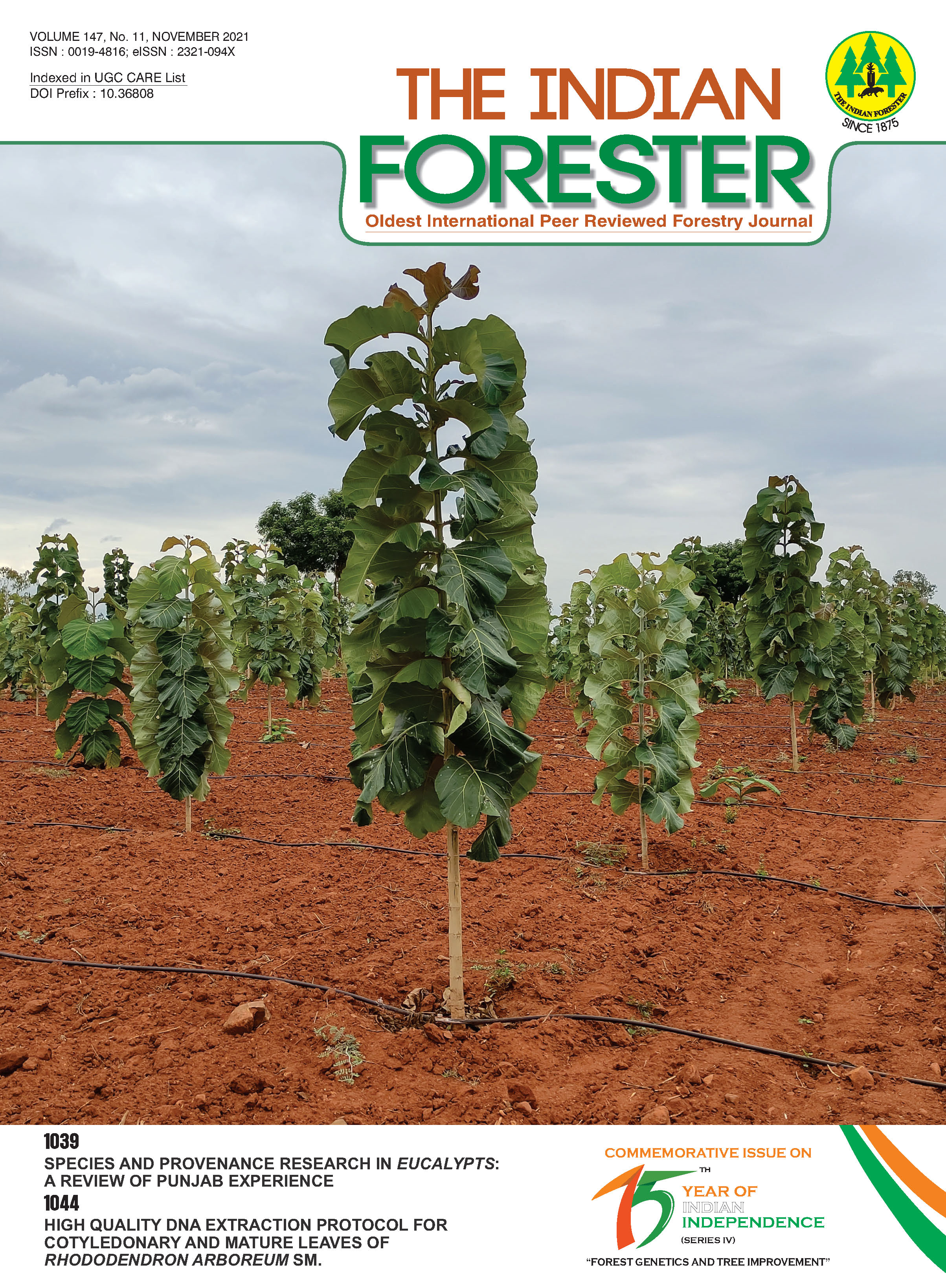Spines as a Rare Character Observed on The Endocarps of Elaeocarpus angustifolius Bl., The Rudraksha Plant from India
DOI:
https://doi.org/10.36808/if/2021/v147i11/156239Keywords:
Elaeocarpus angustifolius, endocarp, spine, RudrakshaAbstract
No Abstract.References
Baba Y. (2013). Evolution, systematics and taxonomy of Elaeocarpus (Elaeocarpaceae) in Australia. Ph. D. Thesis, James Cook University, Australia, p. 136.
Bhuyan P. (2002). Ecological studies on seed production, dispersal, germination and seedling fitness of Rudraksh (Elaeocarpus ganitrus Roxb.). Ph. D Thesis, Department of Botany, North-Eastern Hill University, Shillong, Meghalaya, India.
Brandis D. (1921). Indian trees, British Indian Empire. Constable and Company Ltd., London. 4th Impression, page 102.
Coode M.J.E. (1984). Elaeocarpus in Australia and New Zealand. Kew Bull., 39: 509-586.
Coode M.J.E. (2010). Elaeocarpus for Flora Malesiana: new taxa and understanding in the Ganitrus Group. Kew Bull., 3: 355-399.
Coode M.J.E. (2014). Elaeocarpus for Flora Malesiana: the Monocera group in western Malaysia. Kew Bulletin, 69(1):1-16.
Gagul J.N., David Y.P.T. and Darren M.C. (2018). Fruit developmental biology and endosperm rumination in Elaeocarpus ruminatus (Elaeocarpaceae) and its taxonomic significance. Australian Systematic Botany, 31: 409-419.
Hardainiyan S., Nandi B.C. and Kumar K. (2015). Elaeocarpus ganitrus (Rudraksha): a reservoir plant with their pharmacological effects. Int. J. Pharm. Sci. Rev. Res., 34(1): 55-64.
Joshi S.C. and Jain P.K. (2014). A review on ethnomedicinal and traditional uses of Elaeocarpus ganitrusRox. (Rudraksha). Int. J. Pharm. Bio. Sci., 5(1): 495-511. Bhuyan P. (2002).
Kanjilal U.N., Kanjilal B.C. and Das A. (1934). Family Elaeocarpaceae. In: Flora of Assam, pp. 170-172.
Khan M.L., Bhuyan P. and Tripathi R.S. (2003). Regeneration of Rudraksha (Elaeocarpus ganitrus) – a threatened tree species: Germination strategies. International Journal of Ecology and Environmental Science, 29: 255-260.
Murti S.K. (1993a). Elaeocarpaceae. In. Flora of India, Vol. 3: 528-573. Eds. B.D. Sharma and M. Sanjappa, Botanical Survey of India, Calcutta.
Murti S.K. (1993b). Family Elaeocarpaceae in India - Census and observations. J. Economic & Taxonomic Botany, 17: 283296.
Rao R.R. and Haridasan K. (1983). Threatened plants of Meghalaya – a plea for conservation. In An Assessment of Threatened Plants of India (eds Jain, S. K. and Rao, R. R.), Botanical Survey of India, Howrah, 1983, pp. 94–103.
Roxburgh W. (1832). Flora Indica: Descriptions of Indian plants. Printed for W. Thacker and Co., Calcutta and Parbury, Allen and Co., London, pages 592-594.
Rozefelds A.C. and Christophel D.C. (1996). Elaeocarpus (Elaeocarpaceae) fruits from the Oligo Miocene of eastern Australia. Papers and Proceedings of the Royal Society of Tasmania, 130: 41-48.
Seetha K.N. (2005). Power of Rudraksha. Jaico Publishing House, Delhi, India.
Singh A.N. (2018). Recent trends in import and export of Rudraksha beads in India. Journal of Non Timber Forest products, 25(4): 127-130.
Singh A.N. (2019). Abnormal fruits and endocarps in Elaeocarpus ganitrus Roxb. ex G. Don, the Indian Rudraksha plant. J. Non Timber Forest Product, 26(4): 191-194.
Singh A.N. (2021). Phenology and morphometric attributes of the flower and fruit of cultivated Elaeocarpus ganitrus Roxb. ex G. Don, the Indian Rudraksha plant. Indian Forester, 147(2): 147-153.
Tilak A., Gangwar S.S., Thakur R.N. and Sharma R. (2017). Elaeocarpus ganitrus (Rudraksha) medicinal use in modern time. Imp. J. Interdisc. Res., 3(1): 1531-1538.
Zmarzty S. (2001). Revision of Elaeocarpus (Elaeocarpaceae) - Section Elaeocarpus in Southern India and Sri Lanka. Kew Bulletin, 56(2): 405-447.
Downloads
Downloads
Published
How to Cite
Issue
Section
License
Unless otherwise stated, copyright or similar rights in all materials presented on the site, including graphical images, are owned by Indian Forester.





